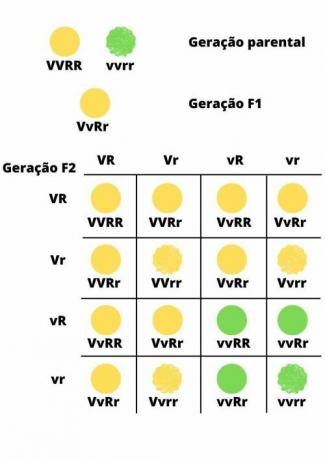Mendel's laws were formulated by Gregor Mendel, who for years of his life was dedicated to understanding how the characteristics of individuals are passed from generation to generation.
Due to his contributions to the studies of the heredity, Mendel is considered the "father of genetics". The principles elaborated by Mendel are also called Mendelian genetics and are the basis of classical genetics.
At the time of his research, the scientific community did not recognize his findings, it was only the from 1900, after Mendel had passed away, that scientists and geneticists rediscovered their studies.
Mendel's First and Second Law
Before Mendel, other scientists had already dedicated themselves to understanding the phenomenon of heredity, but it was Mendel who was successful in these experiments, especially because of the plant he used, The sweet pea (Pisum sativum).
These peas had some characteristics that facilitated the observation of the results: short life cycle, easy cultivation, the ability to self-fertilize, the large number of offspring and easy-to-be observed.
Mendel's discoveries were influenced by the Evolution theory from Charles Darwin, who described that all species had a common ancestor and that evolution over time led to the formation of all species on the planet.
See also the meaning of Evolution theory.
Mendel's First Law
Mendel's First Law, also called Factor Segregation Law, states that every characteristic of an individual is formed by two factors, one from the mother, the other from the father. See the definition of this law:
All characteristics of an individual are determined by genes that segregate, separate, during the formation of gametes, so that the father and mother transmit only one gene to their descendants.
To reach such a conclusion, Mendel defined a characteristic to be observed, in this case the "color of the seeds", and made the crossing of two pure seeds. Pure seeds are those that for 6 generations reproduce only seeds of the same color.
Thus, the cross was made between a green pea seed (vv) and a yellow pea seed (VV). This cross is called the parental generation and resulted in only yellow seeds (Vv), which were called the F1 generation.
The seeds of the F1 generation were self-fertilized and as a result, Mendel obtained three yellow seeds and one green seed, as shown in the figure below:

As a result of this experiment, Mendel concluded that characteristics are formed by pairs of factors and that there are dominant and recessive factors. In this case, yellow is dominant and green is recessive.
Thus, it is concluded from this result that the characteristics are formed by a pair of factors, that they are hereditary and transmitted by genes, with one gene coming from the mother and the other gene coming from the father.
Learn more about Mendel's First Law and heredity.
Mendel's Second Law
Mendel's Second Law is also called the Independent Segregation Law or Dibridism and says that one feature is unrelated to another. See the statement:
Different traits are inherited regardless of differences in other traits observed.
To reach this conclusion, Mendel observed how the transmission of more than one feature at the same time and for this he crossed yellow and smooth seeds and green and wrinkled seeds, both from pure plants.
At yellow and smooth seeds had dominant traits (VVRR) and the wrinkled green seeds had recessive features (vvrr). As a result of the first fertilization, all new seeds were yellow and smooth.
Then, with F1 hybrid seeds (VvRr), Mendel performed self-fertilization and as a result obtained different characteristics, or phenotypes, as shown in the table:

As a result of this crossing, seeds of different phenotypes were obtained, being: 9 yellow and smooth, 3 green and smooth, 3 yellow and wrinkled and 1 green and wrinkled.
After performing this experiment, Mendel concluded that the features are transmitted independently, that is, they are not related. In this case, it meant that a yellow seed would not necessarily be smooth and a green seed would not necessarily be rough.
See also the meanings of gene, genome and DNA.


